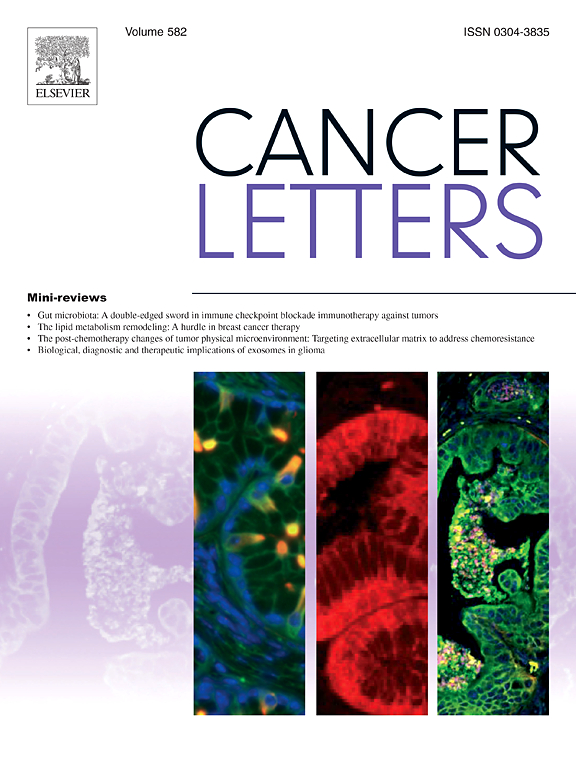The role of tumor microenvironment and immune cell crosstalk in triple-negative breast cancer (TNBC): Emerging therapeutic opportunities
IF 9.1
1区 医学
Q1 ONCOLOGY
引用次数: 0
Abstract
Triple-negative breast cancer (TNBC) is an aggressive subtype characterized by its lack of estrogen, progesterone, and HER2 receptors, leading to limited treatment options and poor prognosis. This review synthesizes current research on the tumor microenvironment (TME) and immune cell crosstalk in TNBC to identify emerging therapeutic opportunities. The TME in TNBC is a complex ecosystem comprising immune cells, fibroblasts, and extracellular matrix components, which significantly influence tumor growth and metastasis. Single-cell RNA sequencing reveals T-cell heterogeneity and identifies prognostic genes. Regulatory T cells (Tregs) play a key role in immunosuppression, with thymidine kinase-1 (TK1) identified as a potential therapeutic target. MUC1-C and CXCL9 modulate the TME, impacting T-cell depletion and macrophage differentiation. Spatial analysis highlights the importance of cell-to-cell interactions in predicting recurrence. Epithelial-mesenchymal transition (EMT) and thermogenesis also influence the TME, while epigenetic modifications, such as HDAC inhibition, can induce pyroptosis and enhance immune cell recruitment. Integrating genomic information with TME analysis is crucial for developing personalized treatments, considering racial disparities in immune infiltration. Emerging therapies targeting immune checkpoints, modulating Treg activity, and inducing pyroptosis hold promise for improving TNBC patient outcomes. Future research should focus on multi-omics data, spatial transcriptomics, and patient-derived models to refine therapeutic interventions.
肿瘤微环境和免疫细胞串扰在三阴性乳腺癌(TNBC)中的作用:新的治疗机会
三阴性乳腺癌(TNBC)是一种侵袭性亚型,其特征是缺乏雌激素、孕激素和HER2受体,导致治疗选择有限和预后不良。本文综述了TNBC中肿瘤微环境(TME)和免疫细胞串扰的最新研究,以确定新的治疗机会。TNBC中的TME是一个复杂的生态系统,包括免疫细胞、成纤维细胞和细胞外基质成分,它们显著影响肿瘤的生长和转移。单细胞RNA测序揭示t细胞异质性并鉴定预后基因。调节性T细胞(Tregs)在免疫抑制中发挥关键作用,胸苷激酶-1 (TK1)被确定为潜在的治疗靶点。MUC1-C和CXCL9调节TME,影响t细胞耗竭和巨噬细胞分化。空间分析强调了细胞间相互作用在预测复发中的重要性。上皮-间质转化(Epithelial-mesenchymal transition, EMT)和产热也影响TME,而表观遗传修饰,如HDAC抑制,可以诱导热亡和增强免疫细胞募集。考虑到免疫浸润中的种族差异,将基因组信息与TME分析相结合对于开发个性化治疗至关重要。针对免疫检查点、调节Treg活性和诱导焦亡的新兴疗法有望改善TNBC患者的预后。未来的研究应集中在多组学数据、空间转录组学和患者衍生模型上,以完善治疗干预措施。
本文章由计算机程序翻译,如有差异,请以英文原文为准。
求助全文
约1分钟内获得全文
求助全文
来源期刊

Cancer letters
医学-肿瘤学
CiteScore
17.70
自引率
2.10%
发文量
427
审稿时长
15 days
期刊介绍:
Cancer Letters is a reputable international journal that serves as a platform for significant and original contributions in cancer research. The journal welcomes both full-length articles and Mini Reviews in the wide-ranging field of basic and translational oncology. Furthermore, it frequently presents Special Issues that shed light on current and topical areas in cancer research.
Cancer Letters is highly interested in various fundamental aspects that can cater to a diverse readership. These areas include the molecular genetics and cell biology of cancer, radiation biology, molecular pathology, hormones and cancer, viral oncology, metastasis, and chemoprevention. The journal actively focuses on experimental therapeutics, particularly the advancement of targeted therapies for personalized cancer medicine, such as metronomic chemotherapy.
By publishing groundbreaking research and promoting advancements in cancer treatments, Cancer Letters aims to actively contribute to the fight against cancer and the improvement of patient outcomes.
 求助内容:
求助内容: 应助结果提醒方式:
应助结果提醒方式:


